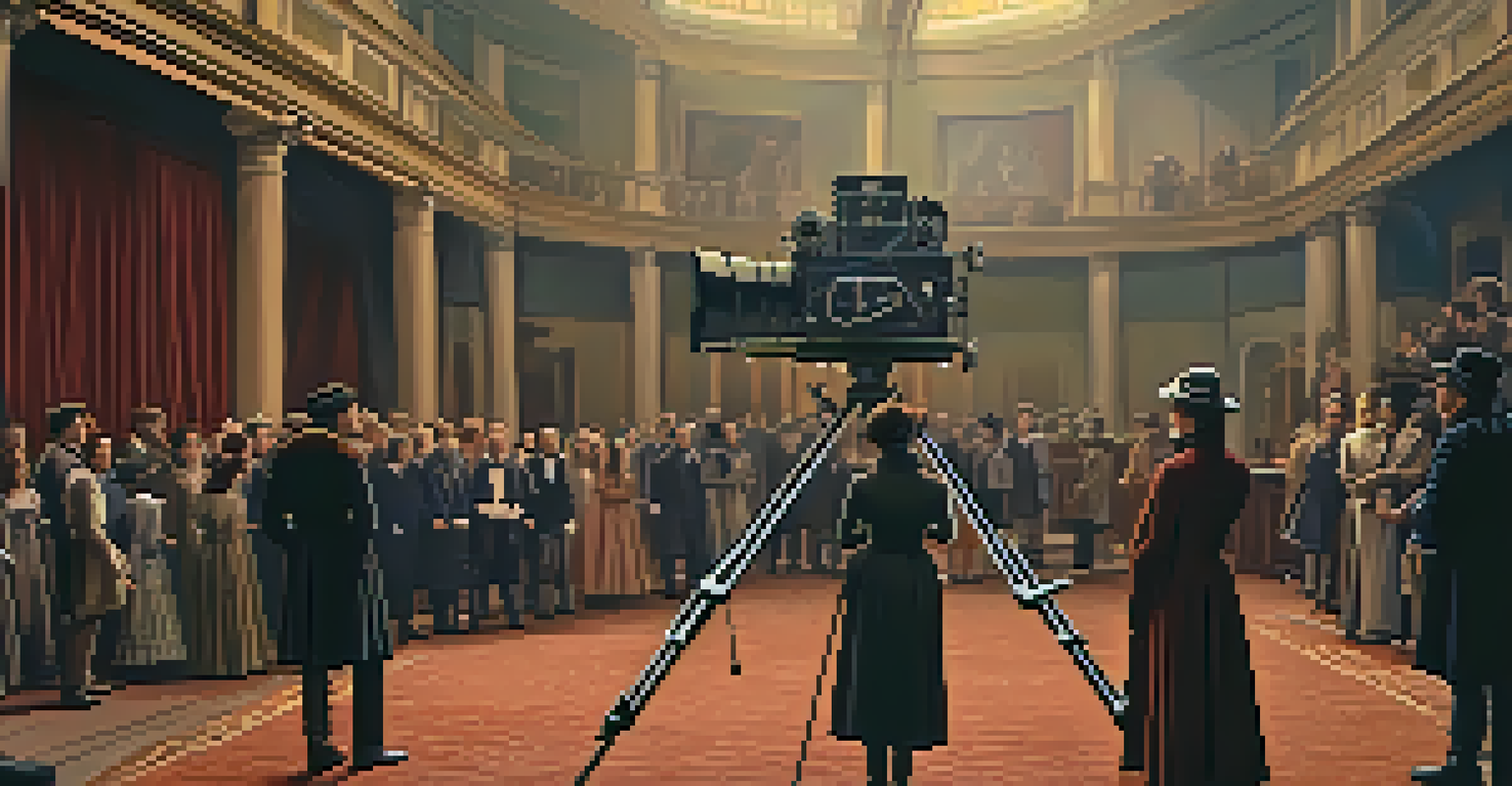From Page to Screen: The Art of Adapting Literature into Film

Understanding the Adaptation Process: A Creative Journey
Adapting literature into film is a fascinating journey that starts with selecting the right book. Not every literary work translates well to the screen, as some stories are deeply tied to their written form. A successful adaptation requires the filmmakers to identify the core themes and essence of the story while considering how to visualize them. This creative process is akin to distilling a complex potion into a single, powerful elixir.
Books are a uniquely portable magic.
Once a story is chosen, the adaptation process involves a delicate balance of preserving the original narrative while making necessary changes. Filmmakers often need to condense lengthy plots, streamline characters, or even change settings to fit the visual medium. This can feel like turning a sprawling novel into a concise haiku, where every word counts and must resonate with the audience.
Ultimately, the adaptation process is about translating emotions and experiences from the page to the screen. It's a collaboration between writers, directors, and actors who interpret the source material through their unique lenses. This collaborative effort results in a film that can evoke the same feelings as reading the book, but in a completely different way.
The Importance of Character Development in Adaptations
Characters are often the heart and soul of any story, whether in books or films. In literature, readers spend time understanding characters’ thoughts and motivations, which may not always be conveyed as deeply in films. A successful adaptation must ensure that character development is preserved or enhanced, giving actors the chance to bring these characters to life on screen with authenticity.

For example, consider the adaptation of 'The Great Gatsby.' While the book delves into Gatsby’s inner turmoil, the film needs to visually express these emotions through actions, expressions, and interactions. This might involve reimagining certain scenes or adding new elements that highlight a character’s journey without straying too far from the original intent of the author.
Adapting Stories Requires Balance
Filmmakers must skillfully balance preserving the essence of the original narrative while making necessary changes to suit the visual medium.
Balancing character depth while maintaining a film's pace can be challenging. However, when done right, it allows the audience to connect with the characters on a profound level, making the viewing experience both engaging and memorable. In this way, the film can transform the reader's imagination into a vivid visual experience.
Setting the Scene: Visualizing Literary Worlds
One of the most significant challenges in adapting literature into film is recreating the rich settings described in the books. Authors often paint intricate landscapes with their words, immersing readers in unique worlds. The filmmakers' task is to translate these vivid descriptions into visual elements that feel authentic and engaging on screen.
The best adaptations happen when the filmmakers honor the original work while bringing their own unique vision to the screen.
For instance, when adapting J.K. Rowling's 'Harry Potter' series, the filmmakers created a stunning visual representation of Hogwarts, making it a character in its own right. The detailed sets and special effects brought the magic of the wizarding world to life, captivating audiences and fans of the books alike. This transformation showcases how crucial setting is in establishing the tone and atmosphere of the story.
Moreover, the choice of locations, color palettes, and cinematography all play a vital role in conveying the story’s mood. Just as an author uses descriptive language to evoke feelings, filmmakers use visual storytelling techniques to create an immersive experience. This synergy between text and visuals can make or break an adaptation.
The Role of Screenwriters: Bridging Literature and Film
Screenwriters are the unsung heroes of the adaptation process, taking the original narrative and crafting it into a screenplay. Their job involves not only translating dialogue but also structuring the story for a visual medium. This often means reimagining scenes, developing subplots, and finding the right pacing to keep audiences engaged.
For example, when adapting a lengthy fantasy novel, a screenwriter might condense several chapters into a single scene to maintain momentum. This requires a deep understanding of the source material and the ability to discern what is essential for the film. It’s a bit like a chef who must select only the freshest ingredients to create a delicious dish while respecting the original recipe.
Character Depth is Crucial
Successful adaptations enhance character development, allowing actors to authentically portray complex emotions on screen.
Ultimately, the screenwriter's vision helps shape how the story is perceived by the audience. Their work is vital in ensuring that the essence of the book is preserved while also crafting a narrative that feels fresh and dynamic on screen. This delicate balance is what makes adaptations both challenging and rewarding.
Balancing Faithfulness and Creativity in Adaptations
One of the most debated topics in literary adaptations is the balance between staying faithful to the source material and allowing creative liberties. While some fans expect strict adherence to the book, others appreciate a fresh take that offers new perspectives. Finding this balance is crucial for filmmakers, as it can determine how well the adaptation is received by audiences.
Take the adaptation of 'The Shining,' for example. While Stanley Kubrick's film deviated significantly from Stephen King's novel, it has gained a cult following for its unique interpretation. This illustrates how a bold creative choice can lead to a different but equally compelling experience, even if it diverges from the original storyline.
Ultimately, the goal of any adaptation should be to honor the source material while also creating a standalone piece of art. This requires filmmakers to make thoughtful decisions that respect the original work while engaging a new audience. When done successfully, adaptations can breathe new life into beloved stories, inviting both new and old fans to experience them in fresh ways.
Audience Expectations: Navigating Book to Film Reactions
When a beloved book is adapted into a film, audience expectations can be sky-high. Readers often have their own interpretations of characters, settings, and events, which can lead to differing opinions once the film is released. Filmmakers face the challenge of meeting these expectations while also creating a product that stands alone as a piece of cinematic art.
For example, the adaptation of 'Pride and Prejudice' has seen several interpretations over the years, each offering a unique take on Jane Austen's classic. Some fans prefer the 1995 miniseries for its fidelity to the text, while others enjoy the modern twists in subsequent films. This variance in opinion highlights the diverse ways audiences connect with literary works and how adaptations can resonate differently.
Innovation Shapes Future Adaptations
As storytelling evolves, filmmakers are exploring new formats and technologies, leading to richer and more varied adaptations.
Navigating these expectations requires a keen understanding of the source material and its audience. Filmmakers must strike a balance between honoring the original and taking creative risks that might attract new viewers. In the end, successful adaptations often embrace this complexity, creating films that foster discussions and reflections on the stories we love.
The Future of Adaptations: Trends and Innovations
As the landscape of storytelling evolves, so do the methods of adapting literature into film. With advancements in technology and changing audience preferences, filmmakers are exploring innovative ways to bring stories to life. From streaming platforms producing serialized adaptations to incorporating interactive elements, the future of adaptations is both exciting and promising.
For instance, the rise of limited series adaptations allows for deeper exploration of complex narratives, giving characters and plots room to breathe. This format can lead to richer storytelling, as seen in adaptations like 'The Handmaid's Tale.' By providing more screen time, these adaptations can stay faithful to the source material while exploring nuances that might be lost in a traditional film.

Moreover, the blending of genres and formats opens up new possibilities for storytelling. As audiences crave diverse narratives, filmmakers are increasingly looking to lesser-known literary works, bringing fresh stories to the forefront. This shift not only enriches the cinematic landscape but also invites viewers to discover new literature, creating a mutually beneficial relationship between books and films.